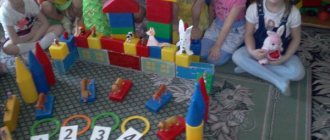Presentation “Game in the life of a preschooler”
GAME
IN THE LIFE OF A PRESCHOOL CHILDREN
Teacher of preschool educational institution No. 9
Popova Yulia Vladimirovna
Relevance, validity, need for the development of role-playing games.
Preschool childhood is a short but important period of personality development. During these years, the child acquires initial knowledge about the life around him, he begins to form a certain attitude towards people, towards work, develops skills and habits of correct behavior, and develops a character.
Play
is an intrinsic form of activity for a preschool child. Replacing play with other types of activity impoverishes the preschooler’s personality, preventing the development of the preschooler’s imagination, which is recognized as the most important age-related neoplasm, inhibits the development of communication with both peers and adults, and impoverishes the child’s emotional world.
A little history.
So, back in 1928, Tikheeva E.I. emphasized that “Free Play” is the most important factor organizing the life of children in kindergarten. It is important to note. What exactly is Tikheyeva E.I. was the first to raise the question of diagnosing the play activities of children in kindergarten, developed a scheme for monitoring children’s games, and proposed the widespread use of photographic recordings of games with their subsequent analysis.
According to L.S.
Vygotsky, the main criterion of the game is an imaginary situation, which represents the space between the real (optical) and semantic (imaginary) field. In this case, the player must be both inside and outside the game at the same time. Thus, one can understand the psychological essence of the game only by being simultaneously inside and outside it, that is, by becoming a participant.
Usova A.P. (1947) the leading pedagogical principles of game management were formulated. She emphasized that in play the child reflects impressions of the environment. She put forward the position that the teacher should guide not so much the game itself, but rather the development of the child’s imagination and thoughts, not prescribe a plan, but encourage him to think about it.
Play is an important means of mental education for a child. The knowledge gained in kindergarten and at home finds practical application and development in the game. Reproducing various life events, episodes from fairy tales and stories, the child reflects on what he saw, what was read and told to him; the meaning of many phenomena, their meaning becomes more clear to him.
Most games reflect the work of adults;
children imitate the household chores of their mother and grandmother, the work of a teacher, doctor, teacher, driver, pilot, astronaut. Consequently, games instill respect for all work that is useful for society, and affirm the desire to take part in it ourselves.
Thus, play (especially creative role-playing) prepares the child for the transition to a new stage of development and is the most important institution for the socialization of a preschooler.
The game fulfills its developmental functions only when it is a child’s activity, independent, or amateur.
Preschool childhood is a sensitive period of play.
If at this time the child has played enough from the heart, then in the future he will easily adapt to any situations, taking on different roles. Kravtsova E.E., Kravtsov G.G.
What does play provide for a child’s development?
1. The ability to act in terms of ideas, thanks to which the development of productive imagination occurs; 2. The ability to navigate in the sphere of human relations; 3. The ability to coordinate one's actions with others.
Children want to play and consider play to be their favorite activity at home and in kindergarten.
The paradox is that often children do not know how to play, how to develop the game plot. The modern preschooler has no place to learn to play. In such a situation, the kindergarten teacher should convey the gaming experience to the child. Therefore, the game must be taught.
Modern pedagogical technologies for organizing the play activities of preschoolers are technologies based on the ideas of pedagogical support.
Its peculiarity lies in the fact that when interacting with children, the teacher flexibly changes his position depending on the degree of manifestation of independence and creativity of the children, and actively cooperates with them.
The teacher needs to develop the ability to be a player, a child’s play partner.
This quality is called the play position of the educator. The principles of the playing position are based on the general principles of the game: 1. Self-worth; 2. Non-utilitarian; 3. Voluntariness; 4. Gaming equality presupposes mastery of the in-game language expressed in facial expressions, words, gestures, and plastic movements.
Pedagogical guidance of play or pedagogical support of children's play activities.
The peculiarity of pedagogical support for gaming activities is that. When interacting with children, the teacher flexibly changes his position depending on the degree to which the children demonstrate independence and creativity, and actively cooperates with them.
The principles that formed the basis of the presented story game “Hospital”
The game position of the teacher is based on the general principles of the game and involves mastering the in-game language expressed in words, gestures, facial expressions, and plastic movements.
Pedagogical support for children's play activities includes:
1. Carrying out regular diagnostics of experience and taking into account its results; 2. The presence of a play position that flexibly combines direct and indirect methods of interaction between the teacher and children; 3. A gradual change in the tactics of pedagogical support; 4. Selection of game content based on the interests and preferences of modern preschoolers; 5. the teacher’s orientation towards the individual creative manifestations of children; 6. Creation of a modern subject-game environment.
A teacher working with children achieves several goals:
1. Gradually develops play experience; 2. Helps children reflect the world in play; 3. Encourages children to show their first creative expressions; 4. Fosters a desire for playful communication with peers.
Pedagogical support for play activities with children of the third year of life:
The leading idea of pedagogical support for children’s games is to help the child master the conventions of play actions. This determines the tasks of the work aimed at children mastering the game as a special type of activity:
1. Inclusion in the game of actions with toys and objects and actions without objects;
2. Replacement in the game of well-known objective actions with actions with substitute objects, and then with words; 3. Transfer of actions characteristic of the character and the relationships of the characters;
4. Animating a toy, attributing desires and emotional states to it;
5. Verbal explanation of game actions, substitute objects and imaginary objects; 6. Independent development of semantic chains from two or three game actions; 7. Entering into interaction with a peer based on the exchange of objective actions.
Organization of situations of play interaction between a teacher and children aged
2-2.5 years: 1. When playing with children, the teacher “animates” the toys, ascribes to them desires that are understandable to children, and then emotional states; 2. A complication of such gaming situations is the attribution of not only desire, but also an emotional state to the toy; 3. Games are then possible using the opposing desires of the game character and the emotional states associated with them;
4. To establish a connection between game actions, it is convenient for the teacher to use the phrase “first-then”;
5. Then games are organized using substitute objects, indicating well-known but currently absent toys. 6. It is often necessary to frame the child’s objective actions with an imaginary situation.
Organization of situations of playful interaction between a teacher and children aged 2.5-3 years:
1. Revitalizing the child’s ideas in a conversation; 2. Appeal and clarification of children's ideas through the teacher's story; 3. Encouraging children to play out situations; 4. Creating a game problem situation 5. Including verbal elements from songs, books, cartoons into the game.
Pedagogical diagnostics of plot play in children of the third year of life, proposed by O.V. Solntseva, the main method of pedagogical diagnostics, which is observation of the child’s play manifestations, contains evaluation criteria and indicators.
Let's look at some of them.
1. The ability to reflect a variety of content in a role-playing game.
The child: a) reflects the everyday actions of adults in the plot; b) reflects the professional actions of adults in the plot; c) reflects in the plot the content (episodes) of familiar poems, fairy tales or cartoons.
2. Mastering role behavior:
a) the presence of a connection between game actions and a specific image; b) manifestation of an emotional attitude towards toys;; c) the use of role-playing speech aimed at toys; d) the use of role-playing speech “for a toy”; d) the ability to name your role.
3. The ability to use game substitution actions.
The child: a) uses objective play actions; b) uses actions with substitute objects; c) uses simple figurative play actions.
By the end of the third year of life, the child begins to perform a play role, although he cannot always name it.
This requires the teacher to name the child’s role and act accordingly. Children can develop chains of two or three actions with story toys, use substitute objects and name actions with them.
The following methodological literature was used in the presentation:
1. “Preschooler in the world of play.” Accompanying children's story games, O.V. Solntseva; 2. “Development of play activities”, Games with young children, L.N. Galiguzova; 3. Games for children from one to three years old, G.B. Monina, E.V. Larechina.
GAME ACTIVITIES OF PRESCHOOL CHILDREN 1. - presentation
GAME ACTIVITIES OF PRESCHOOL CHILDREN 1
plan 1. Theoretical foundations of the game (methodological, psychological; theories of the origin of the game). 2. The essence of the game as a leading activity. 3. Specific features of children's play (independently). 4. Types of children's games. Approaches to classification (independent). 5. Conceptual models of the development of children's play (D.B. Elkonin, S.L. Novoselova, E.E. Kravtsova) 6. Game technologies. Technologies for guiding the play of a preschooler (types of pedagogical influence) - Technology of an integrated approach (E.V. Zvorygina, S.L. Novoselova) - Technology of teaching play (according to the mechanism of formation of role behavior) (N.Ya. Mikhailenko, N.A. Korotkova) . — the purpose and principles of gaming technologies 7. Subject-game environment of the preschool educational institution. Toy (independently) 8. Diagnosis of a preschooler’s play (independently)
3 THEORETICAL BASIS OF THE GAME 3 Methodological foundations of the game Revealed in the works of G.V. Plekhanov, K.D. Ushinsky: the historical social nature of the game, the connection of the game with work, art. Psychological foundations of the game In the works of L.S. Vygotsky, L.A. Venger, A.N. Leontyev, D.B. Elkonina, N.N. Poddyakova and others define play as a personal concept, not an age-related one: An adult experiences opportunities that have ALREADY not been used, and a child tries on opportunities and desires that have NOT yet been realized.
THEORIES OF THE ORIGIN OF GAME 4 1. Theory of excess nervous forces: G. Spencer, G. Schurz 2. Theory of rest in the game: A. Vallon 3. Theory of instinctivity and exercise: K. Gross, W. Stern 4. Theory of religious origins Johan Huizing, M. Bakhtin, V. Vsevolodsky - Gerngross, A. Sokolov, etc. 5. Theory of functional pleasure, realization of innate drives: K. Büller, Z. Freud, A. Adler 6. Theory of recapitulation (abbreviated repetition): E. Haeckel and anticipation (anticipation of the future): S. Hall, A. Vallon 7. Theory of the spiritual development of a child in play: K.D. Ushinsky, J. Piaget, L.S. Vygotsky, D.B. Elkonin 8. Labor as a source of play G.V. Plekhanov
5 ESSENCE OF GAME - characteristics of game as an activity 5 In theory, game is the leading type of activity 1. The amount of time that the child devotes to it 1. Satisfies the basic needs of the child: the desire for independence, activity; needs for communication, knowledge of the environment 3. In play, other types of activities arise and develop: work, learning 4. Play contributes to the formation of the child’s new formations, his mental processes: imagination
CLASSIFICATION OF GAMES 1. TRADITIONAL: ACCORDING TO THE CENTRAL ELEMENT OF THE STRUCTURE CREATIVE PLOT-ROLE-PLAYING BUILDING GAMES-DRAMATIZATION THEATRALIZED DIRECTOR'S STRUCTURE: ROLE PLOT CONCEPT TOY GAMES WITH RULES DIDACTIC MOVABLE STRUCTURES: GAME TASK GAME ACTIONS RULES RESULT 6
I CLASSIFICATION OF GAMES. Author 2nd CLASSIFICATION OF GAMES. Author: Novoselova S.L. 7 Criterion: on the initiative of the addressee 3 classes of games: 1 class: on the initiative of children, games-experiments: - communication with people, animals, - natural objects, toys, etc. amateur plot: - plot-display, - plot-role-playing, - director's , - theatrical 2nd grade: on the initiative of adults educational: - autodidactic subject, - plot-didactic, - moving, - musical leisure: - fun, - entertainment, - theatrical, - intellectual, - computer others. 3rd grade: on the initiative of children or adults ritual (cult, family, seasonal) training (sensorimotor, adaptive) leisure (games, amusing, entertaining)
3 classification of games: by type of organization 3 classification of games: by type of organization - by the number of children: individual, group - by location: indoors, outdoors - by mode: games in the first and second half of the day 4 classification 4 classification: by content, reflecting: - everyday reality: household (family), industrial (post office, hospital, store, etc.) public (holidays) - fictional events: heroic, fantastic, adventure, romantic, etc. 5 classification 5 classification: by area preschool education: - physical - cognitive, mental - social and personal - artistic and aesthetic 8
9 CONCEPTUAL MODELS OF CHILDREN'S PLAY DEVELOPMENT 9 Concept by D.B. Elkonina: development of the game by changing the role in the game Concept of S.L. Novoselova: development of the game according to the type of game action Concept of E.E. Kravtsova: periodization of the development of the game according to the presence of an imaginary (imaginary) situation
10 CONCEPT D.B. ELKONINA 10 STAGES OF GAME FORMATION According to the criterion: changes in the role in the game 1st stage Approach to the role OBJECT PLAY (up to 3 years) Main content - actions with objects 2nd stage Flourishing of the role ROLE PLAY (from 3 to 7 years ) The main content is a reflection of the relationships between people Stage 3 Degeneration of the role to the pure rule of GAME WITH RULES (6 - 7 years) The main content is Submission to the rules of social behavior and relations between people
CONCEPT S.L. NOVOSELOVOYA 11 STAGES OF GAME DEVELOPMENT according to the criterion: changing the type of play action 1st stage (up to 5-6 months) FAMILIARY GAME Main content: manipulation actions: examination of toys together with an adult 2nd stage (1-2 years) DISPLAY GAME Main content: actions to identify the specific properties of an object, its intended purpose (transfers it to the game) 3rd stage (2-3 years) Plot-DISPLAYMENT Main content: actions simulate in a conditional form the use of an object for its intended purpose 4th stage (3- 7 years) OWN ROLE PLAY 3-4 years – primary; from 5 years - developed game Main content: modeling familiar labor and social relations between people
CONCEPT E.E. KRAVTSOVA 12 Periodization of game development according to L.S. Vygotsky’s criterion: the presence of an imaginary (imaginary) situation 1st floor. Director's play - independently inventing a plot - controlling toys - transferring functions from one object to another 2 floors. Imaginative play - highlighting the main action with an object, characteristic signs of human (animal) behavior - adopting an image, role 3rd floor. Plot-role-playing game - Taking on a role, creating, developing a plot - A SPECIAL FORM OF DIRECTOR'S PLAY: simultaneous performance of a role and management of role-playing relationships 4th floor. Playing with rules Having a certain internal position and image specified by the rules 5th floor. Director's play. High-quality plot enrichment
Game technologies are a certain sequence of actions of the teacher to develop stages and implement game activities: - selection, development and preparation of the game - inclusion of children in the game - implementation of the game itself - summing up the results and results The difference between game technology and other methods of teaching and upbringing: A) allows the child to be personally involved in the action, B) gives the opportunity to live in “real” life conditions
Technologies for managing the game, the pedagogical position of an adult, is aimed at: Formation of the game as an activity - expansion of the themes of the games - deepening the content of the games - children's mastery of play (role-playing) behavior Using the game as a means of child development, formation of the children's team (levels): 1st - disorganized behavior 2nd – single games 3rd – side-by-side games 4th – short-term communication 5th – long-term communication 6th – constant interaction 14
Types of pedagogical influence: game management game management are aimed at the formation of the game: as a process of pedagogical influence, on transferring to children the methods of gaming activities Game management Direct methods of influence involve the inclusion of an adult in the game process, direct participation in it Game management Indirect methods of influence in order to maintain an independent character Games Comprehensive Guide 15
Components of the method of complex management of the game (E.V. Zvorygina, S.L. Novoselova) 1st component: Enrichment of experience, familiarization with the environment through active activity (to transfer knowledge into the game) 2nd component: Teaching children how to reproduce reality in games 3rd component: Organization of a subject-play environment 4th component: Activating communication between an adult and a child during the game 16
Technology of game management N.Ya. Mikhailenko and N.A. Korotkova MECHANISM FOR FORMING ROLE BEHAVIOR Guidance - as a process of gradually transferring to a child ways of constructing a game according to the stages of its formation first stage (1-2.5 years) Mastering conditioned actions with toys and objects - substitutes second stage (2.5 – 4.5 years) Mastering role behavior, relationships and interactions third stage (4.5 – 7 years) Mastering methods of constructing a plot (plot composition) 17
THE GOAL of pedagogical game technologies is a focus on developing creativity and initiative in children PRINCIPLES of pedagogical game technologies PRINCIPLES of pedagogical game technologies are based on the pedagogy of cooperation: - absence of authoritarianism (imposing the theme of games, partners, objects) - development of game dynamics - support of the game atmosphere - construction of a “play space” » together with children - the relationship between play and non-play activities 18





